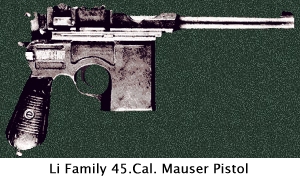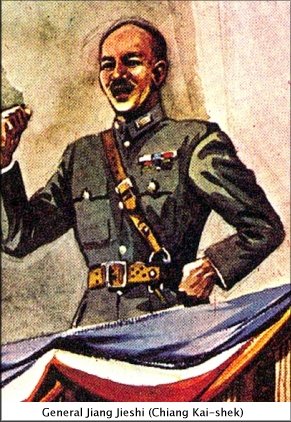“Be simple and natural in your actions. Move like lightning, hit like thunder and disappear like clouds.” – Li, Longdao.
Li, Longdao – The Last Daoqiquan Master
Li, Longdao was born in 1890 in the county now called Daofu in Sichuan province of China. Daofu is located in a zone that borders the Qinghai-Tibet high plateau; it is a mountainous area rich in pine forests. The son of Master Li, Zhang-Lai, Longdao was born into a family of professional Baobiao or bodyguards that made their living by escorting rich merchants from city to city.
Longdao was born in the year of the horse at the hour of the dragon, both auspicious signs. His father named him Longdao or “dragon follower of wisdom” as he felt Longdao was to help his family restore the Chinese peoples to the way of life that existed before the coming of the Manchu reign.
 In 1900, Longdao, at age 10, began learning the basics of the family martial art from his grandfather Li, Ren-Ma (1801 – 1913). The Daoqiquan family system consisted of practical, direct hand to hand combat, weapons and survival skills based on what is now called the internal Chinese martial arts. Legend has it that, in over 100 years, no one under the protection of the Li family was ever killed or seriously harmed. Masters of Chinese boxing, knife, sword and firearms, the Li families kept a low profile but were still in high demand by those in need of protection.
In 1900, Longdao, at age 10, began learning the basics of the family martial art from his grandfather Li, Ren-Ma (1801 – 1913). The Daoqiquan family system consisted of practical, direct hand to hand combat, weapons and survival skills based on what is now called the internal Chinese martial arts. Legend has it that, in over 100 years, no one under the protection of the Li family was ever killed or seriously harmed. Masters of Chinese boxing, knife, sword and firearms, the Li families kept a low profile but were still in high demand by those in need of protection.
Longdao continued his martial education with his father Li, Zhang-Lai, who had been taught Li, Ching-Yuen’s Baguazhang from his father. Li, Zhang-Lai soon became the driving force behind Nine Dragon Baguazhang™. Master Zhang-Lai also incorporated a type of Zhan Zhuang standing practice into the system and mastered Xingyiquan martial skills.
At the age of 26, Li, Longdao joined his family business as a Baobiao at a time when China was immersed in civil unrest. It was the year of the warlord reign in China. The Li family profited during this time by working for military warlords, and as mercenary bodyguards they developed great skills in hand to hand and weapons fighting with swords and firearms.
Before escaping to Taiwan, the young Li had served with distinction as a bodyguard and combat trainer for soldiers. He had fought beside his father in many battles and skirmished along the China-Tibet border as well as upon the famous “Silk Road.”
A Martial Innovator
“When you must fight evade all attacks, seek the most vulnerable place and strike like a tiger rushing out of a cave or a Dragon suddenly appearing from behind a cloud.” – Li, Longdao
As a martial innovator Li, Longdao is today credited with creating what he called the five animal styles of Daoqiquan. The animal methods of Daoqiquan were training sets comprised of eighteen hand formations for attacking pressure points. He called these: The Tiger Hand Set, The Leopard Hand Set, The Snake Hand Set, The Crane Hand Set, and the Dragon Hand Set.
In the year 1928 when Li, Longdao was 38 years old, warlords ruled much of the country and there was much civil unrest. Shortly after his first son was born, the family was forced to move due the continued civil unrest  which saw land owners killed and their property distributed to the people. The Li family sought work where it could be found among rebel armies and for warlords. Li, Zhan
which saw land owners killed and their property distributed to the people. The Li family sought work where it could be found among rebel armies and for warlords. Li, Zhan g-Lai and his son trained soldiers for General Jiang Jieshi (Chiang Kai-shek) as he worked to reunite Inner China in the famous Expedition from Guangzhou.
g-Lai and his son trained soldiers for General Jiang Jieshi (Chiang Kai-shek) as he worked to reunite Inner China in the famous Expedition from Guangzhou.
Some time during the 1930’s, Li, Longdao set out on travels to Shanghai and Beijing to gather information to help him when he assumed his father’s position. It is believed that during these travels he may possibly have met the founder of Yiquan, Master Wang Xiangzhai in Shanghai, and learned something of the Yiquan system. At any rate, a form of standing or Zhandou Zhan Zhuang that Li, Longdao dubbed Yizhang (Mind Palm) became a part of his training regimen. This concept of mind energy/power appears in his Xingyiquan and Baguazhang methods.
“Truly understand the meaning hidden in the Taiji symbol and there is nothing else I can teach you about life, martial art or healing.” – Li, Longdao
Flight from China
In or around 1943 the Li family, disheartened possibly by the rise of communism, ran afoul of some petty government official and was forced to flee from mainland China. Li, Zhang-Lai took his son Li, Longdao and, along with their wives and two eldest sons, travelled across China. It soon became clear that they would not be safe anywhere on the mainland and so the family escaped into Taiwan in fear of their lives. Hearing of opportunity in America, they made their way to San Francisco and later to New York.
The large cities did not suit them, being used to the pine forests and mountains of their home in Sichuan. A friend in New York told them about the conifer-laden forests and rolling hills of East Texas, and the family moved to the state in 1945. The Li family settled first in East Mountain near the town of Longview. Selection of this location was no coincidence.
Li, Zhang-Lai, a believer in Feng Shui (a type of Chinese geomancy), had named his eldest son Longdao, a combination of two words meaning “dragon wisdom.” When looking for a town in Texas, he came upon the town Longview. The elder Li, not having a clear grasp of English, thought that the town name meant “dragon view” and since they were from the East and looking for a mountain, this seemed the only logical choice.
In 1946, Li, Zhang-Lai died at the age of 96 and Li, Longdao at 56 assumed the role of Master of Daoqiquan. In the new country there was no need for his services as a Baobiao and he entered into a deep state of depression. He attempted to continue his son’s education in Daoqiquan and soon discovered that the Chinese boys had become more interested in western life and the money brought in by the new family business, a restaurant in downtown Longview. David, his youngest son, told his father that no one was interested in these old ideas.
Master Li took a job in his sons’ business shelling peas, waiting tables, and cleaning dishes. It was a terrible loss of face for a man who, only a few years before, was showered with gifts and accolades by Chinese warlords, land barons and merchants who needed his services to stay alive. Despite the chiding of his sons, the elder Li continued to train and practice each morning at dawn, dusk and again at midnight in the backyard of their Texas home.
“Every step, every action must contain the potential for releasing full body power.” – Li, Longdao.
In the winter of 1956 Li, Longdao met his neighbor and American benefactors’ son, John Painter, a sickly boy of 13. After teaching the boy a form of Chinese yoga standing exercises to improve his health, Li, Longdao at the age of 67 had found his new pupil and began teaching John Painter and a friend Robert Cohen the ancient Li family traditional arts of Daoqiquan.
The Return to China.
Near the end of 1969, Master Li at age 79, wrote a letter to John Painter adopting him as his martial arts son. The letter enraged Li, Longdao’s sons, who had become successful businessmen but had not chosen to have completed their martial art training. Proud of John Painter’s accomplishments in learning Daoqiquan, but bitterly disappointed in his sons who refused to learn the family traditions and arts, Li, Longdao, the Last Master of Daoqiquan, bid his sons and John Painter farewell as he prepared to return to China.
His last words to John Painter were, ” You still have much to learn. Experience will teach you if you will open your mind and spirit. This road will be hard and full of difficulty. Once, these things were secrets in our family. It needs to be taught openly now. I hope you can manage to keep this art alive and pass it on to others who need it. I leave it with you now; do not bring shame on our family.”
The elder Li boarded a bus for New York and from there returned to Taiwan. During the fall of 1980, David Li contacted John Painter to tell him that his father, Li, Longdao had died at the age of 100 in their home county of Daofu in Sichuan province.
“The goal of true combat is to avoid combat if at all possible.” – Li, Longdao.
| About Daoqiquan and its history. Throughout this Website we present information, facts and stories concerning the art of Jiulong Baguazhang™ and its history. Most of the historical information was derived from notes taken by John Painter over 30 years ago. The source of these notes was Li, Longdao, the last master of the Daoqiquan system.Whenever possible, we have made sincere efforts to consult with Chinese scholars of martial arts, history and medicine to verify and gather data to substantiate our position. We have no doubt made some errors in transliteration of Chinese to English, exact dates and historical information. For these mistakes, we beg the reader’s indulgence. |
If you would like to find out more about Jiulong Baguazhang and would like to talk with other students of this martial art, about the art, then you might want to consider joining our Jiulong Baguazhang Facebook Group. Click below to join.